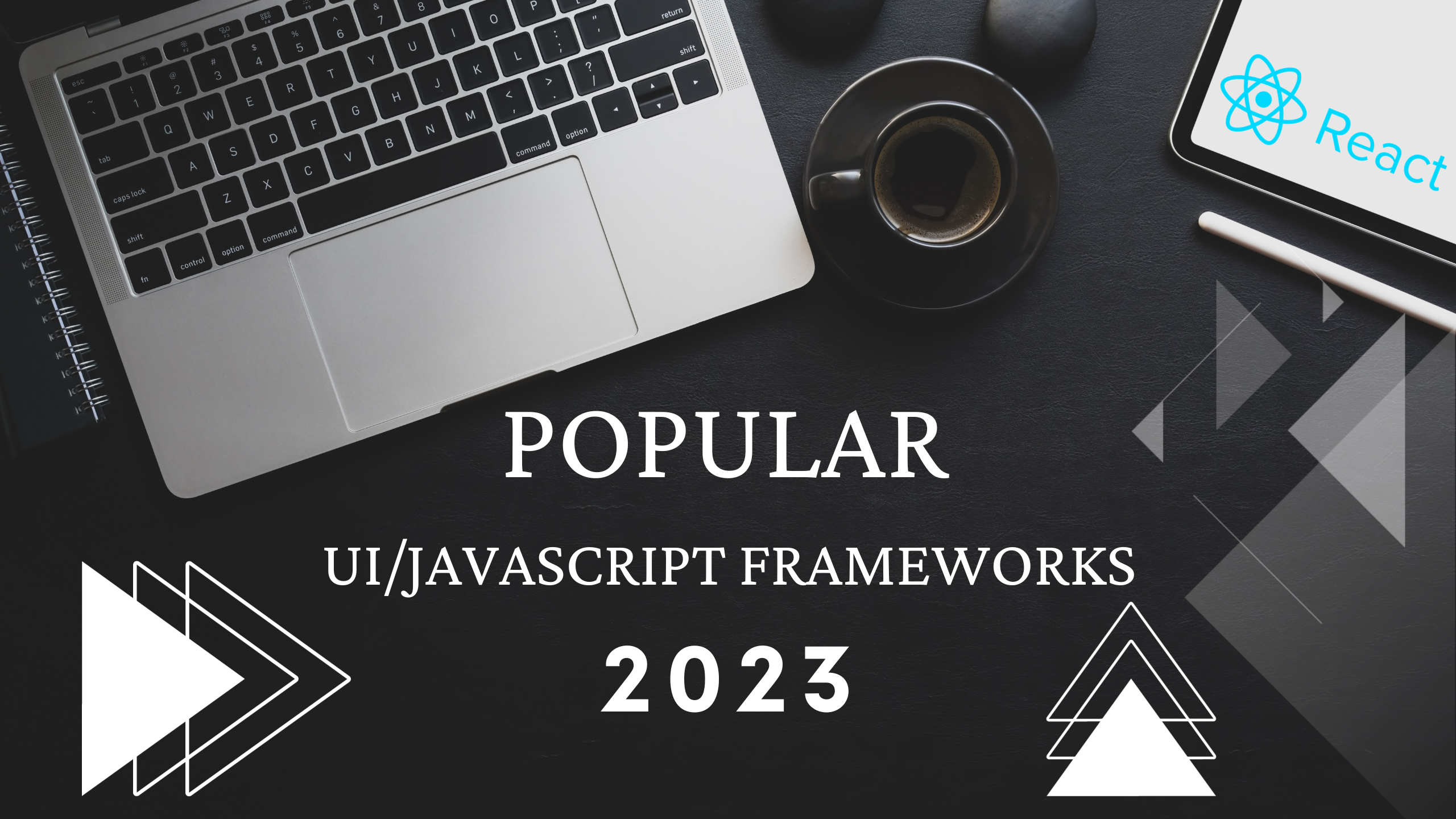Diving into the dynamic realm of web development in 2023, it’s crucial for developers to keep their fingers on the pulse of the latest UI/JavaScript frameworks. These frameworks aren’t just tools; they’re game-changers, unlocking possibilities for developers to craft applications that are both sturdy and user-friendly.
Join us as we explore their standout features, and uncover real-world examples showcasing their prowess. Get ready to ride the wave of innovation in the ever-evolving landscape of web development! 🚀
JavaScript Frameworks?
Before diving into the specifics of the most popular frameworks, it’s important to understand what UI and JavaScript frameworks are and why they are essential for web development.
| Aspect | UI Frameworks | JavaScript Frameworks |
|---|---|---|
| Focus | Streamlines UI development, offering ready-to-use components. | Enhances overall web app development, focusing on efficiency. |
| Components | Pre-defined UI elements like buttons, forms, menus, and modals. | Tools for data-binding, component architecture, routing, etc. |
| Developer’s Emphasis | Allows devs to concentrate on app functionality and logic. | Aids in building complex and interactive applications. |
| Ease of Use | Simplifies repetitive UI tasks, easing the development process. | Optimizes JavaScript with features for smoother coding. |
| Application Scope | Specifically targets user interface elements and visuals. | Broadens the scope to overall web application development. |
Understanding UI and JavaScript frameworks is like having a superhero toolkit for web development. UI frameworks handle the aesthetic side, making your app look stunning without breaking a sweat. Meanwhile, JavaScript frameworks step in to supercharge your coding journey, adding capabilities and efficiencies that turn complex tasks into a walk in the digital park. 💻
Now that we have a basic understanding of UI and JavaScript frameworks, let’s explore the most popular ones in 2023.
The Top 4 Most Popular UI/JavaScript Frameworks in 2023
In 2023, several UI/JavaScript frameworks have gained significant popularity among web developers. These frameworks offer a range of features and capabilities that cater to different development needs.
Let’s take a closer look at the top 4 frameworks in 2023:
1. ReactJS 🏅
ReactJS, developed by Facebook, has consistently topped the charts as one of the most popular JavaScript frameworks. It is widely used to build interactive user interfaces for web applications. With its component-based architecture and virtual DOM, ReactJS allows developers to create reusable UI components and efficiently update the UI when the underlying data changes.
Key Features of ReactJS:
- Component-based Architecture: ReactJS follows a component-based approach, allowing developers to break down the UI into reusable and self-contained components. This promotes code reusability, maintainability, and modularity.
- Virtual DOM: ReactJS utilizes a virtual DOM, which keeps a lightweight representation of the actual DOM in memory. This enables efficient and optimized updates to the UI, resulting in improved performance.
- JSX Syntax: ReactJS incorporates JSX (JavaScript XML) syntax, which allows developers to write HTML-like code within JavaScript. This seamless combination of HTML and JavaScript enhances code readability and simplifies the creation of complex UI structures.
- One-way Data Flow: ReactJS follows a unidirectional data flow pattern, also known as Flux architecture. This ensures predictable data updates and makes it easier to understand how data changes propagate through the application.
Real-world Example: Facebook
One of the most notable real-world examples of ReactJS is its usage in Facebook. Facebook’s News Feed, a core feature of the platform, is built using ReactJS. The component-based architecture of ReactJS allows Facebook to efficiently manage and update the News Feed UI as new posts and updates are added.
Sample Code
let’s take a quick stroll through a simple ReactJS snippet to showcase its charm compared to other JavaScript frameworks. Imagine we’re building a classic to-do list component that talks to an API.
// React makes your components dance with joy!
import React, { useState, useEffect } from 'react';
import axios from 'axios';
const TodoList = () => {
const [todos, setTodos] = useState([]);
useEffect(() => {
// Fetching data from our magical API
axios.get('https://api.todos-awesome.com/todos')
.then(response => setTodos(response.data))
.catch(error => console.error('Oops, something went wrong:', error));
}, []);
return (
<div>
<h1>My Awesome Todo List</h1>
<ul>
{todos.map(todo => (
<li key={todo.id}>{todo.title}</li>
))}
</ul>
</div>
);
};
export default TodoList;2. Angular
Angular, a framework developed by Google, is another popular choice among web developers. It enables the development of dynamic single-page applications using the MVC (Model-View-Controller) architectural pattern. Angular provides an extensive set of features and tools for building complex and scalable applications.
Key Features of Angular:
- MVC Architecture: Angular follows the MVC architectural pattern, separating the application’s logic, presentation, and data into distinct components. This promotes code organization, modularity, and maintainability.
- Dependency Injection: Angular has built-in support for dependency injection, allowing developers to easily manage dependencies between different components of an application. This enhances code reusability, testability, and maintainability.
- Directives: Angular incorporates directives, which extend HTML with custom behaviors and enable the creation of reusable components. Directives provide flexibility and modularity to the application’s UI.
- Templating Engine: Angular utilizes a powerful templating engine that enables the creation of dynamic HTML templates. This declarative approach simplifies the integration of data and logic into the UI, resulting in interactive and responsive web applications.
- Testing Support: Angular offers excellent support for unit testing, providing tools and frameworks like Jasmine and Karma. This facilitates the testing of individual components, services, and controllers, ensuring the reliability and quality of Angular applications.
Real-world Example: Microsoft Office
Microsoft Office, a widely used suite of productivity applications, utilizes Angular for its web-based version. Angular’s robust features and scalability make it an ideal choice for building complex applications like Microsoft Office, which require dynamic and interactive user interfaces.
Sample Code
Below is a simple code snippet showcasing how Angular shines in comparison to other JavaScript frameworks. In this example, we’ll touch on Angular’s approach to API integration, dependency injection, and the elegance of directives.
// Angular Code
// API Integration in Angular
import { Injectable } from '@angular/core';
import { HttpClient } from '@angular/common/http';
import { Observable } from 'rxjs';
@Injectable({
providedIn: 'root',
})
export class DataService {
private apiUrl = 'https://api.example.com';
constructor(private http: HttpClient) {}
getData(): Observable<any> {
return this.http.get(`${this.apiUrl}/data`);
}
}
// Dependency Injection in Angular
import { Component } from '@angular/core';
import { DataService } from './data.service';
@Component({
selector: 'app-root',
template: `
<div>
<h1>{{ data.title }}</h1>
</div>
`,
})
export class AppComponent {
data: any;
constructor(private dataService: DataService) {
this.dataService.getData().subscribe((response) => {
this.data = response;
});
}
}
// Directives in Angular
import { Directive, Input, ElementRef, Renderer2 } from '@angular/core';
@Directive({
selector: '[appHighlight]',
})
export class HighlightDirective {
@Input() highlightColor: string = 'yellow';
constructor(private el: ElementRef, private renderer: Renderer2) {}
ngOnChanges() {
this.renderer.setStyle(this.el.nativeElement, 'background-color', this.highlightColor);
}
}
3. Vue.js
Vue.js, often referred to as the “progressive JavaScript framework,” has gained significant popularity in recent years. It is known for its simplicity, ease of learning, and versatility. Vue.js allows developers to incrementally adopt its features, making it suitable for both small, interactive components and large-scale single-page applications.
Key Features of Vue.js:
- Easy to Learn: Vue.js has a gentle learning curve, making it an excellent choice for beginners. Its simple syntax and intuitive API enable developers to quickly get started with building components and applications.
- Component-based Architecture: Vue.js follows a component-based architecture, enabling developers to create self-contained modular components with their own logic, styles, and templates. These components can be easily composed to build complex user interfaces.
- Reactive Data Binding: Vue.js leverages a reactive data binding system, automatically updating the UI when the underlying data changes. This simplifies state management and synchronization, resulting in more maintainable and predictable code.
- Performance Optimization: Vue.js is designed to be performant, leveraging a virtual DOM for efficient updates to the UI. Additionally, Vue.js generates highly optimized JavaScript code, resulting in smaller bundle sizes and faster initial load times.
- Integration: Vue.js offers flexibility when integrating with existing projects. It can be used as a standalone framework or gradually introduced into an existing codebase. Vue.js also supports integration with other libraries and existing projects.
Real-world Example: Alibaba
Alibaba, one of the world’s largest e-commerce companies, uses Vue.js extensively in its frontend development. Vue.js enables Alibaba to build responsive and interactive user interfaces for its online shopping platforms, providing a seamless user experience.
Sample Code
Let’s dive into a simple example showcasing how Vue.js stands out with its user-friendly syntax, reactive data binding, and component-based architecture compared to other JavaScript frameworks.
<!-- HTML - The Template -->
<template>
<div>
<h1>{{ greeting }}</h1>
<button @click="changeGreeting">Say Hi!</button>
<my-component :message="greeting"></my-component>
</div>
</template>
<!-- JavaScript - The Logic -->
<script>
export default {
data() {
return {
greeting: 'Hello, Vue.js!',
};
},
methods: {
changeGreeting() {
this.greeting = 'Hola, Vue!';
},
},
};
</script>
<!-- Vue Component - Reusable -->
<template>
<div>
<p>{{ message }}</p>
</div>
</template>
<script>
export default {
props: ['message'],
};
</script>
4. Svelte
Svelte is a relatively new and innovative JavaScript framework that has gained attention for its unique approach to building user interfaces. Unlike traditional frameworks, Svelte compiles components into highly efficient JavaScript code during the build process, resulting in excellent performance and smaller bundle sizes.
Key Features of Svelte:
- Efficient Performances: Svelte’s compilation process produces highly optimized JavaScript code, resulting in exceptional app performance and smaller bundle sizes. This leads to faster load times and a better overall user experience.
- Easy to Learn: Svelte has a minimalistic syntax and API, making it easy to understand and learn. Its simplicity allows developers to quickly start building components and applications without a steep learning curve.
- Reactive Data Binding: Svelte leverages reactive data binding, similar to other frameworks like Vue.js and React. This ensures that the UI updates automatically when the underlying data changes, simplifying state management and synchronization.
- No Virtual DOM: Unlike other frameworks that rely on a virtual DOM for efficient updates, Svelte compiles components into imperative code that directly manipulates the DOM. This approach eliminates the overhead of virtual DOM diffing, potentially resulting in faster rendering and update cycles.
Real-world Example: The New York Times
The New York Times, one of the world’s leading news organizations, has adopted Svelte for its web development. Svelte’s efficient performance and smaller bundle sizes make it an ideal choice for news websites that require fast loading times and smooth user interactions.
Sample Code
Below is a simple code snippet showcasing how Svelte differs from other JavaScript frameworks, focusing on its approach to API handling, efficient performance, and absence of traditional data binding.
<script>
import { onMount } from 'svelte';
// API handling in Svelte
let data = {};
onMount(async () => {
const response = await fetch('https://api.example.com/data');
data = await response.json();
});
</script>
<style>
/* Your styles go here */
</style>
<main>
<!-- Efficient performance with minimal overhead -->
<h1>{data.title}</h1>
<p>{data.description}</p>
<!-- No traditional data binding -->
<button on:click={() => alert('Svelte is Awesome!')}>
Click me!
</button>
</main>These four frameworks – ReactJS, Angular, Vue.js, and Svelte – have proven to be the most popular choices among web developers in 2023.
Each framework offers unique features and capabilities, catering to different development needs and preferences. By understanding the key features and real-world examples of these frameworks, developers can make informed decisions when choosing the right framework for their projects.
Common Use Cases
Now that we have explored the top 4 UI/JavaScript frameworks, let’s look at some common use cases and real-world examples of their applications.
ReactJS Use Cases:
- Social Media Platforms: ReactJS is widely used in developing social media platforms like Facebook, Instagram, and Twitter. Its component-based architecture and efficient rendering make it a suitable choice for handling complex UI interactions and real-time updates.
- E-commerce Websites: ReactJS is commonly employed in building e-commerce websites due to its ability to handle large amounts of data and provide seamless user experiences. Platforms like Amazon and eBay utilize ReactJS to create dynamic and interactive shopping interfaces.
- Collaborative Tools: ReactJS is often used to develop collaborative tools like Trello and Asana. Its reusable components and efficient rendering enable real-time collaboration and smooth UI interactions.
Angular Use Cases:
- Enterprise Applications: Angular is widely used in developing enterprise-level applications that require complex business logic and scalability. Its comprehensive feature set, including dependency injection and testing support, makes it suitable for building robust and maintainable enterprise applications.
- Streaming Platforms: Angular is utilized in streaming platforms like Netflix and Twitch for delivering seamless streaming experiences. Its ability to handle complex UI interactions and manage large amounts of data makes it an ideal choice for such applications.
- Admin Dashboards: Angular is commonly employed in building admin dashboards and management systems. Its component-based architecture and extensive set of UI components make it easy to create responsive and feature-rich admin interfaces.
Vue.js Use Cases:
- Single-page Applications: Vue.js is often used to develop single-page applications (SPAs) due to its simplicity and versatility. SPAs like GitLab and Behance utilize Vue.js for their frontend development, providing smooth and interactive user experiences.
- Mobile Applications: Vue.js can be used with frameworks like NativeScript and Weex to build cross-platform mobile applications. Its ease of learning and flexible integration make it a suitable choice for mobile app development.
- Interactive Interfaces: Vue.js is commonly employed in developing interactive interfaces for media and entertainment platforms. Services like Hulu and HBO Max utilize Vue.js to create engaging and user-friendly interfaces for content consumption.
Svelte Use Cases:
- Data Visualization: Svelte is often used in data visualization applications, where performance and efficient rendering are critical. Platforms like D3.js have integrated Svelte to create interactive and visually appealing data visualizations.
- Web Components: Svelte’s compilation process makes it an ideal choice for building web components that can be used across different frameworks and projects. Its small bundle sizes and efficient performance make it suitable for creating reusable and lightweight web components.
- Progressive Web Applications: Svelte is commonly employed in building progressive web applications (PWAs) that offer native-like experiences on the web. Its ability to compile components into highly optimized JavaScript code results in fast-loading PWAs with seamless interactions.
By understanding the common use cases and real-world examples of these frameworks, developers can identify the best framework for their specific project requirements and leverage their unique features to build high-performing and user-friendly applications.
Conclusion
Among this diverse array of choices, React.js 🏆 emerges as the undisputed champion, solidifying its position as the top contender in 2023.
What sets React.js apart is not just its longevity in the field but its continual evolution, adapting to the changing needs of developers and businesses alike. React’s component-based architecture, virtual DOM, and seamless integration with other technologies make it a powerhouse for building dynamic and scalable user interfaces.
Surveying the job market and examining the pulse of the developer community through platforms like Stack Overflow reveals a resounding endorsement for React.js. Job listings consistently prioritize React expertise, reflecting the high demand for professionals skilled in this framework. The Stack Overflow Developer Survey, a compass for industry trends, echoes this sentiment with React.js consistently ranking as one of the most loved and widely used frameworks.
BuzzCoder view on what you should learn, adapt & grow:
| Category | JavaScript Frameworks on Your Radar for 2023 |
|---|---|
| Front-end Frameworks | React.js, Vue.js, Angular, Svelte |
| Back-end Frameworks | Node.js (Express.js), Django, Flask, Ruby on Rails |
| Promising Frameworks | Next.js, Nuxt.js, NestJS, Alpine.js, Astro |
In essence, React.js has not just maintained its relevance but has become the go-to choice for developers aiming to craft modern, performant, and maintainable web applications. The journey may be dynamic, but in 2023, React.js remains the beacon guiding developers toward unparalleled success in crafting exceptional user experiences.
Remember, the world of web development is constantly evolving, and staying updated with the latest frameworks is essential for developers to thrive in the industry. So, explore, experiment, and embrace the power of UI/JavaScript frameworks to unleash your full potential as a web developer.
If you’ve got any burning questions or need guidance on your coding journey, don’t hesitate to reach out! Head over to Contact Us or drop your query at Ask BuzzCoder. We’re here to help you unlock the exciting world of coding! Happy coding!






